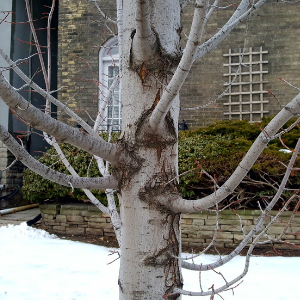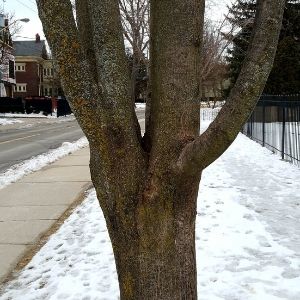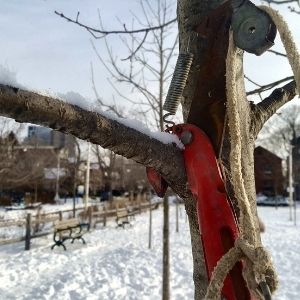Pruning is a common type of tree maintenance which can fulfill different objectives as a tree ages. Objectives are generally established by both a certified arborist and homeowner and can include:
- Removing broken, dead, dying or diseased branches
- Establishing a strong growth form (structural pruning)
- Creating clearance for vehicles or pedestrians
- Thinning large, heavy branches
- Reducing risk
Establishing pruning objectives helps determine why, when and how a tree will be pruned. Given the lifelong impact pruning can have, every cut should serve a specific function. A good practice is to ask and answer the following question before each cut: I am removing this branch because _________.

This tree has some tightly spaced and crossing branches. Pruning can correct these defects and encourage proper growth structure.
Structural pruning is a type of pruning that aims to develop long-lived, low-risk, stable trees. Growth defects usually begin to develop at an early age and tend to become worse as a tree matures. Prioritizing structural pruning while a tree is young is important because it can help correct any problems before they progress too far. Once a tree has matured, heavy corrective pruning can cause serious stress. This means that making a small pruning cut when the tree is young ultimately does less damage than making a large one once the tree has started to mature.
Structural pruning can help promote proper trunk development, encourage good branching structure and establish permanent branches. Some pruning strategies can include removing branches that cross and correcting double leaders- a leader is the vertical stem at the top of the trunk. Barring a few species, most urban trees should only have one leader but can develop more if unmanaged.

This tree has a more than one main leader, which could have been easily corrected by structural pruning when the tree was younger.
Newly planted trees should only be pruned to remove broken, dead, dying or diseased branches. Young trees should be structurally pruned three to five years after planting once they have established in the ground. Because leaves create sugar (i.e. food) for a tree, no more than a quarter of the tree canopy should be removed in any one year. Pruning any more can inhibit a tree’s ability to produce its own food, which can cause stress, reduce growth and potentially lead to death.
For the most part, the best time to prune young trees is in late fall, throughout the winter or early spring. There are four benefits to pruning during this time.
- Temperatures are cooler, which can limit the spread of disease
- Trees get a head start on healing wounds before spring growth begins
- Structural pruning decisions are easier to make when branches are visible without leaves
- Pruning before animals begin rearing their young reduces the risk of disturbing local wildlife
For more information on pruning young trees, visit the Trees Are Good website.

Pruning should not be done haphazardly. Each cut should serve a pre-established objective.
Pruning can have lifelong effects on your tree so it’s important to make sure that it’s done properly. Because pruning requires skill and knowledge, it’s important to speak to an arborist who has been certified through the International Society of Aboriculture (ISA) before making your first cut. We developed a factsheet to help you select a qualified tree care company.
We also offer corrective pruning services for young trees (less than 14 feet in height) planted through the LEAF Backyard Tree Planting Program. Pruning is done by one of our ISA certified arborists. To learn more visit our Maintenance and Pruning Services page.
Jess Wilkin is the Residential Planting Programs Operations Coordinator. She holds a Master’s of Forest Conservation from the University of Toronto.
The Backyard Tree Planting Program is supported by the City of Toronto, the Regional Municipality of York, Durham Region, the City of Markham, the Town of Newmarket, the Town of Ajax, the City of Oshawa, the City of Pickering, the Township of Scugog, the Town of Whitby and Ontario Power Generation.
